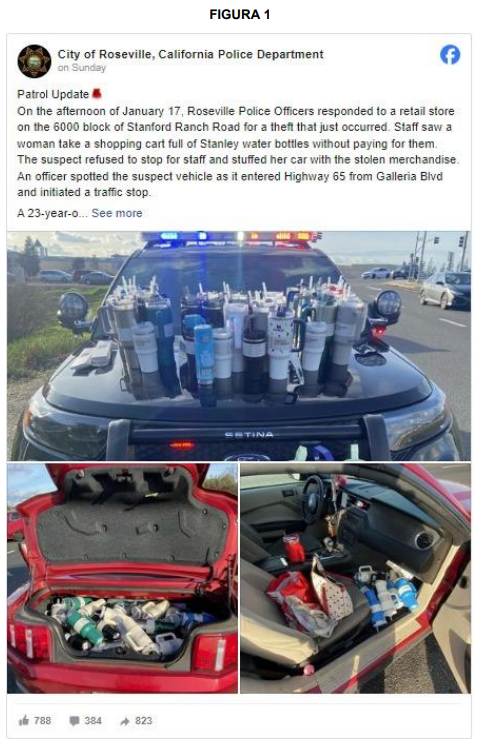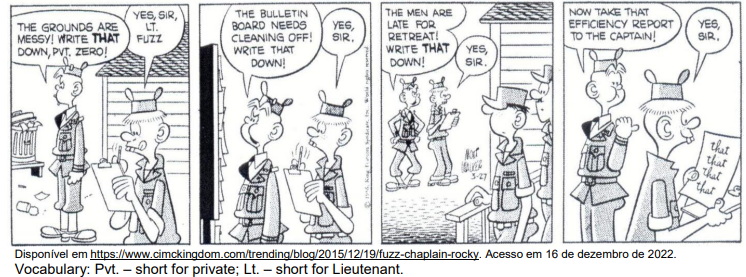Questões Militares Comentadas sobre inglês
Foram encontradas 2.927 questões


“Bright Star is a joint exercise. It is _____ important part of combat training. Servicemen and women from _____ army, navy and air force participate in _____ exercise. It takes place in _____ north-east of Egypt, near _____ Mediterranean. They practise military skills.”
“As a soldier you may not make _____ money but you’ll make _____ true friends. Perhaps you’ll have _____ idle time than you expected but you’ll get a lot of glory in serving in your country.”
NON-COMISSIONED OFFICER OF THE YEAR
COMBAT ARMS NCO ACADEMY (ESA), Três Corações – Sergeant Major Rodrigo Pereira Menezes __________ (be) 17 years old when he ________ (decide) to become an NCO. He _______ (join) the Brazilian Army in March 7, 1994. He _______ (be) in the Army for 29 years. Since his graduation, he _______ (serve) in five different states across Brazil. For his exemplary service and impeccable career, the Combat Arms NCO Academy awards SGT MAJ Menezes with the prize NCO of the Year.
The Soldier’s Life: Radio Basics
Radios are vital military tools. They allow soldiers to stay in contact during combat and other operations. Most radios are made to hop frequencies. This system prevents enemy from listening to the full conversations. The SINCGARS (man-pack) and AN/PRC-148 (handheld) are common military radios.
Choose the right option to answer the question: What’s the meaning of “stay in contact” in the text?
Sergeant Brooks: Can you tell me _____ you last saw Private Johnson?
Corporal Diaz: I last saw him in Colonel Grant’s office.
Sergeant Brooks: _____ did you see him exactly?
Corporal Diaz: Five minutes before lunch break.
Sergeant Brooks: And _____ was he doing there?
Corporal Diaz: He was repairing the colonel’s computer.
Sergeant Brooks: _____ was he with?
Corporal Diaz: Nobody. He was alone.
Sergeant Brooks: _____ did you go to the Colonel’s Office?
Corporal Diaz: Because I had to take documents to Colonel Grant before he left for lunch.
LOCAL TERRORISTS AMBUSH ROUTINE PATROL
Four soldiers were injured yesterday because a bomb ________ (explode) near their armored vehicle. The incident _______ (happen) at 4.30 pm while the soldiers _______ (return) to base after a routine patrol. Their vehicle _______ (travel) along the High Street when suddenly they _______ (have) to slow down because a bomb which was hidden in a rubbish bin _______ (explode).
A pistol is a sidearm. Soldiers can aim and fire it with one hand. Pistols are _____ than other firearms, making them useful in close combat.
Read the comic strip.

All the statements are correct with one exception. Now mark the only statement
that is wrong according to the comic strip.
Choose the option that correctly corresponds to the blank spaces.
“Remember that where ________ courageous soldiers, _________ eternal glory.”
When Johnny comes marching home By Patrick Sarsfield Gilmore
When Johnny comes marching home again Hurrah! Hurrah!
We’ll give him a hearty welcome then Hurrah! Hurrah!
The men will cheer and the boys will shout The ladies they will all turn out
[…]
Disponível em https://www.battlefields.org/learn/primary-sources/civil-war-music-when-johnny-comes-marching-home-again. Acesso em 22 de dezembro de 2022.
Read the song and choose the correct answer.
I. Most political positions in Brazil are today taken up by women.
II. Housework is one of the factors that may prevent women from getting better qualification.
III. Brazil has contributed with extensive evidence for the debate on gender equity in fire management.
Choose the correct answer:
The opposite of “often” in “Climate change is often discussed” (2nd paragraph) is
I. The effects of climate change exclude wildfires.
II. Global warming is not a current problem.
III. The number of wildfires has been on the rise.
The statements are, respectively,